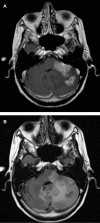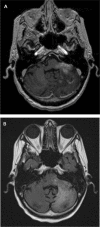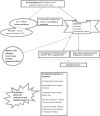Bevacizumab in high-grade gliomas: a review of its uses, toxicity assessment, and future treatment challenges
- PMID: 23620671
- PMCID: PMC3633547
- DOI: 10.2147/OTT.S38628
Bevacizumab in high-grade gliomas: a review of its uses, toxicity assessment, and future treatment challenges
Abstract
High-grade gliomas continue to have dismal prognosis despite advances made in understanding the molecular genetics, signaling pathways, cytoskeletal dynamics, and the role of stem cells in gliomagenesis. Conventional treatment approaches, including surgery, radiotherapy, and cytotoxic chemotherapy, have been used with limited success. Therapeutic advances using molecular targeted therapy, immunotherapy, and others such as dietary treatments have not been able to halt tumor progression and disease-related death. High-grade gliomas (World Health Organization grades III/IV) are histologically characterized by cellular and nuclear atypia, neoangiogenesis, and necrosis. The expression of vascular endothelial growth factor, a molecular mediator, plays a key role in vascular proliferation and tumor survival. Targeting vascular endothelial growth factor has demonstrated promising results, with improved quality of life and progression-free survival. Bevacizumab, a humanized monoclonal antibody to vascular endothelial growth factor, is approved by the Food and Drug Administration as a single agent in recurrent glioblastoma and is associated with manageable toxicity. This review discusses the efficacy, practical aspects, and response assessment challenges with the use of bevacizumab in the treatment of high-grade gliomas.
Keywords: antiangiogenesis; bevacizumab; glioblastoma; glioma; vascular endothelial growth factor.
Figures



Similar articles
-
Targeted Therapeutics in Patients With High-Grade Gliomas: Past, Present, and Future.Curr Treat Options Oncol. 2016 Aug;17(8):42. doi: 10.1007/s11864-016-0418-0. Curr Treat Options Oncol. 2016. PMID: 27334978 Review.
-
Bevacizumab for the treatment of recurrent glioblastoma.Clin Med Insights Oncol. 2011;5:117-29. doi: 10.4137/CMO.S7232. Epub 2011 May 2. Clin Med Insights Oncol. 2011. PMID: 21603247 Free PMC article.
-
Emerging clinical principles on the use of bevacizumab for the treatment of malignant gliomas.Cancer. 2010 Sep 1;116(17):3988-99. doi: 10.1002/cncr.25256. Cancer. 2010. PMID: 20564141 Review.
-
Safety and efficacy of stereotactic radiosurgery and adjuvant bevacizumab in patients with recurrent malignant gliomas.Int J Radiat Oncol Biol Phys. 2012 Apr 1;82(5):2018-24. doi: 10.1016/j.ijrobp.2010.12.074. Epub 2011 Apr 12. Int J Radiat Oncol Biol Phys. 2012. PMID: 21489708 Free PMC article.
-
Antiangiogenic therapy for patients with recurrent and newly diagnosed malignant gliomas.J Oncol. 2012;2012:193436. doi: 10.1155/2012/193436. Epub 2011 Jul 14. J Oncol. 2012. PMID: 21804824 Free PMC article.
Cited by
-
Prognostic and predictive biomarkers in adult and pediatric gliomas: toward personalized treatment.Front Oncol. 2014 Mar 24;4:47. doi: 10.3389/fonc.2014.00047. eCollection 2014. Front Oncol. 2014. PMID: 24716189 Free PMC article. Review.
-
Glioblastoma multiforme: State of the art and future therapeutics.Surg Neurol Int. 2014 May 8;5:64. doi: 10.4103/2152-7806.132138. eCollection 2014. Surg Neurol Int. 2014. PMID: 24991467 Free PMC article. Review.
-
Continuing or ceasing bevacizumab beyond progression in recurrent glioblastoma: an exploratory randomized phase II trial.Neurooncol Pract. 2017 Sep;4(3):171-181. doi: 10.1093/nop/npw025. Epub 2017 May 25. Neurooncol Pract. 2017. PMID: 31386014 Free PMC article.
-
Efficacy and safety of bevacizumab for the treatment of glioblastoma.Exp Ther Med. 2016 Feb;11(2):371-380. doi: 10.3892/etm.2015.2947. Epub 2015 Dec 16. Exp Ther Med. 2016. PMID: 26893618 Free PMC article.
-
Molecularly targeted drugs for metastatic colorectal cancer.Drug Des Devel Ther. 2013 Nov 1;7:1315-22. doi: 10.2147/DDDT.S52485. eCollection 2013. Drug Des Devel Ther. 2013. PMID: 24204124 Free PMC article. Review.
References
-
- Wen PY, Kesari S. Malignant gliomas in adults. N Engl J Med. 2008 Jul 31;359(5):492–507. - PubMed
-
- Giglio P, Villano JL. Newly diagnosed high-grade gliomas. Curr Treat Options Neurol. 2010 Jul;12(4):309–320. - PubMed
-
- Stupp R, Mason WP, van den Bent, et al. Radiotherapy plus concomitant and adjuvant temozolomide for glioblastoma. N Engl J Med. 2005 Mar 10;352(10):987–996. - PubMed
-
- Stupp R, Hegi ME, Gilbert MR, Chakravarti A. Chemoradiotherapy in malignant glioma: standard of care and future directions. J Clin Oncol. 2007 Sep 10;25(26):4127–4136. - PubMed
LinkOut - more resources
Full Text Sources
Other Literature Sources

